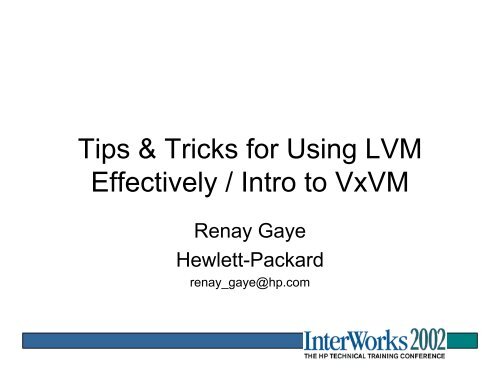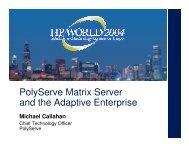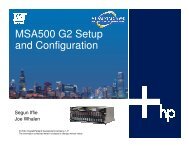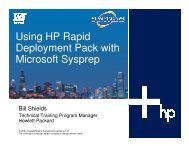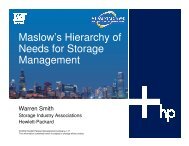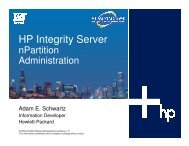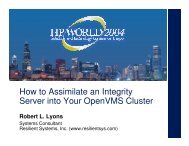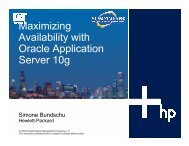Tips and Tricks for Using LVM Effectively, with an ... - OpenMPE
Tips and Tricks for Using LVM Effectively, with an ... - OpenMPE
Tips and Tricks for Using LVM Effectively, with an ... - OpenMPE
You also want an ePaper? Increase the reach of your titles
YUMPU automatically turns print PDFs into web optimized ePapers that Google loves.
<strong>Tips</strong> & <strong>Tricks</strong> <strong>for</strong> <strong>Using</strong> <strong>LVM</strong><br />
<strong>Effectively</strong> / Intro to VxVM<br />
Renay Gaye<br />
Hewlett-Packard<br />
renay_gaye@hp.com
<strong>LVM</strong> Concepts
<strong>LVM</strong> Concepts-Physical Volume<br />
• <strong>LVM</strong> M<strong>an</strong>aged Disk<br />
• Each PV is assigned a unique PVID<br />
pvid<br />
pvcreate /dev/rdsk/cntndn
<strong>LVM</strong> Concepts-Volume Group<br />
• One or more physical volumes<br />
• pool of physical extents<br />
mkdir /dev/vgname<br />
pvra<br />
vgra<br />
extents<br />
pvid<br />
vgid<br />
pvid<br />
vgid<br />
mknod /dev/vgname/group c 64<br />
0xnn0000<br />
vgcreate vgname /dev/dsk/cntndn ...
Volume Group Map<br />
pvid vgid pvid vgid<br />
map<br />
map<br />
extent size (-s n)<br />
* max extents/pv (-e n)<br />
______________________<br />
max. useable space/disk<br />
pv 0<br />
pv 1<br />
pv 2<br />
~<br />
pv 15<br />
pe<br />
0<br />
pe pe pe<br />
pe<br />
1 2 3 1016<br />
~
<strong>LVM</strong> Device Files<br />
/dev<br />
dsk<br />
rdsk<br />
vg01<br />
c0t5d0<br />
c0t5d0<br />
group<br />
VG device<br />
file<br />
c0t6d0<br />
c0t6d0<br />
lvol1<br />
lvol2<br />
Block LV<br />
devicefiles<br />
Block PV<br />
device files<br />
Raw PV<br />
devicefiles<br />
rlvol1<br />
rlvol2<br />
Raw LV<br />
devicefiles
etc/lvmtab<br />
•Non-ascii file<br />
•Records volume<br />
group/physical volume<br />
associations<br />
•Used by m<strong>an</strong>y <strong>LVM</strong><br />
comm<strong><strong>an</strong>d</strong>s <strong>for</strong> s<strong>an</strong>ity<br />
checking<br />
example:<br />
/dev/vg00 (vgid)<br />
/dev/dsk/c0t6d0 (vgid,pvid)<br />
/dev/vg01 (vgid)<br />
/dev/dsk/c1t2d1 (vgid,pvid)<br />
/dev/dsk/c1t2d2 (vgid,pvid)
Volume Group Activation<br />
• Done automatically when vg is created<br />
• automatically at boot (/etc/lvmrc)<br />
• required in order to access <strong>an</strong>y lvols<br />
pvid<br />
vgra<br />
vgid<br />
pvid<br />
vgra<br />
vgid<br />
00<br />
01<br />
vgch<strong>an</strong>ge -a y vgname<br />
vgch<strong>an</strong>ge -a r vgname<br />
Memory
<strong>LVM</strong> Concepts-Quorum<br />
vg01<br />
pvid vgid pvid vgid<br />
• More th<strong>an</strong> 1/2 disks in a vg<br />
required to activate the<br />
volume group<br />
• C<strong>an</strong> override:<br />
vgch<strong>an</strong>ge -a y -q n vg01<br />
• Booting <strong>with</strong>out quorum:<br />
ISL> hpux -lq
<strong>LVM</strong> Concepts-Logical Volume<br />
pvid vgid pvid vgid<br />
map<br />
map<br />
pv 0<br />
pv 1<br />
pv 2<br />
pe<br />
0<br />
pe pe pe pe<br />
pe<br />
1 2 3 4<br />
1016<br />
01 01 01 01 01<br />
~<br />
lvcreate -L n vgname<br />
lvcreate -L n -C y vgname<br />
lvcreate -l n vgname<br />
lvcreate -L n -n name vgname<br />
~<br />
pv 15
Placing logical volumes<br />
pvid vgid pvid vgid<br />
map<br />
map<br />
pv 0<br />
pv 1<br />
pv 2<br />
pe<br />
0<br />
pe pe pe pe<br />
pe<br />
1 2 3 4<br />
1016<br />
01 01 01 01 01<br />
~<br />
02 02 02 02 02 02<br />
~<br />
lvcreate -n datalv vgdata<br />
lvextend -L 500<br />
/dev/vgdata/datalv<br />
/dev/dsk/c4t2d0<br />
~<br />
pv 15
Multi-pathing solutions
Multipathing Solutions <strong>with</strong> <strong>LVM</strong><br />
• <strong>LVM</strong> pvlinks<br />
– active/passive<br />
– no additional software required<br />
• Auto path<br />
– active/active, load bal<strong>an</strong>cing<br />
– supported <strong>for</strong> XP <strong><strong>an</strong>d</strong> VA arrays<br />
– additional cost product<br />
• Powerpath<br />
– active/active, load bal<strong>an</strong>cing<br />
– supported <strong>for</strong> EMC arrays<br />
– additional cost product
PV links<br />
pvcreate /dev/rdsk/c5t5d0<br />
pvcreate /dev/rdsk/c5t5d1<br />
mkdir /dev/vg01<br />
mknod /dev/vg01/group c 64<br />
0x010000<br />
vgcreate vg01<br />
/dev/dsk/c5t5d0 /dev/dsk/c7t5d0<br />
/dev/dsk/c7t5d1 /dev/dsk/c5t5d1<br />
pvid vgid pvid vgid<br />
c5t5d0 (p)<br />
c7t5d0 (a)<br />
c7t5d1 (p)<br />
c5t5d1 (a)
PV links-switching the order<br />
• Temporary Ch<strong>an</strong>ge<br />
pvch<strong>an</strong>ge -s /dev/dsk/c7t5d0<br />
pvid vgid pvid vgid<br />
• Perm<strong>an</strong>ent Ch<strong>an</strong>ge<br />
vgreduce vg01 /dev/dsk/c5t5d0<br />
vgextend vg01 /dev/dsk/c5t5d0<br />
c5t5d0 (p) (a)<br />
c7t5d0 (a) (p)<br />
c7t5d1 (p)<br />
c5t5d1 (a)
Auto Path-Dynamic load<br />
bal<strong>an</strong>cing<br />
• Load bal<strong>an</strong>cing<br />
functionality<br />
– Supports up to 8 paths from a server<br />
to <strong>an</strong> end device<br />
– Provides dynamic load bal<strong>an</strong>cing<br />
across all paths to <strong>an</strong> end device<br />
– Choose from 4 load bal<strong>an</strong>cing<br />
policies, including “no load bal<strong>an</strong>cing”<br />
– Supports the XP <strong><strong>an</strong>d</strong> VA disk arrays<br />
– Load bal<strong>an</strong>cing supported in<br />
clustered environments<br />
HBA HBA HBA HBA HBA HBA HBA HBA<br />
FC<br />
Port<br />
FC<br />
Port<br />
FC<br />
Port<br />
Array<br />
Server<br />
Auto Path<br />
FC<br />
Port<br />
FC<br />
Port<br />
FC<br />
Port<br />
LDEV<br />
FC<br />
Port<br />
C HIP Board 1 C HIP Board 2<br />
FC<br />
Port
Auto Path driver<br />
Application<br />
• A pseudo driver<br />
• The Auto Path driver is<br />
layered between the <strong>LVM</strong><br />
(Logical Volume<br />
M<strong>an</strong>ager) <strong><strong>an</strong>d</strong> the SCSI<br />
device driver<br />
• The driver provides the<br />
Comm<strong><strong>an</strong>d</strong> Line Interface<br />
File System<br />
Logical Volum e M<strong>an</strong>ager<br />
Auto Path<br />
Drivers<br />
(SCSI device <strong><strong>an</strong>d</strong> FC interface)<br />
FC HBA<br />
FC HBA<br />
Disk Array
Moving Data
Moving Disks<br />
Three Step Process<br />
1. Remove definition of volume group<br />
2. Move disk(s)<br />
3. Add definition of volume group<br />
Two comm<strong><strong>an</strong>d</strong>s<br />
vgexport(1m)<br />
vgimport(1m)
Volume Group Definition —<br />
Review<br />
/etc/lvmtab<br />
name ofLogical Volumes<br />
/dev/vg01<br />
/dev/vg01<br />
/dev/dsk/c0t5d0<br />
VGRA + PVRA<br />
group<br />
lvol1<br />
rlvol1<br />
databaselv<br />
rdatabaselv<br />
64 0x010000<br />
64 0x010001<br />
64 0x010001<br />
64 0x010002<br />
64 0x010002<br />
-PV ID<br />
-VG ID<br />
PE to LE map
Exporting a Volume Group<br />
Syntax:<br />
vgexport [-p][-v][-m file]VG<br />
-p Preview actions only<br />
-v verbose<br />
-m used to specify a map file <strong>for</strong>logical volume names<br />
• Removes volume group definition from the system co mpletely by updating<br />
/etc/lvmtab <strong><strong>an</strong>d</strong> kernel memory.<br />
• The volu me group must firstbe deactivated <strong>with</strong> vgch<strong>an</strong>ge(1m).<br />
Example:<br />
vgch<strong>an</strong>ge -a n /dev/vg01<br />
vgexport -v -m /etc/lvmconf/vg01.map /dev/vg01
Importing a Volume Group<br />
Syntax:<br />
vgimport [-p][-v][-m file] VG PV [PV...]<br />
-p Preview actions only<br />
-v verbose<br />
-m used to specify a map file <strong>for</strong> logical volu me nam es<br />
Example:<br />
mkdir /dev/vg01<br />
mknod /dev/vg01/group c 64 0x010000<br />
vgimport -v -m /etc/lvmconf/vg01.map /dev/vg01 /dev/dsk/c0t1d0<br />
vgch<strong>an</strong>ge -a y /dev/vg01<br />
vgcfgbackup vg01
Moving <strong>LVM</strong> Data<br />
Volume group<br />
pvmove<br />
free<br />
free<br />
c0t5d0<br />
c0t4d0<br />
Syntax:<br />
pvmove [-n lv] from_PV [to_PV]<br />
Exa mple:<br />
pvmove -n /dev/vg01/lvol1 /dev/dsk/c0t5d0 /dev/dsk/c0t4d0
Renaming <strong>LVM</strong> objects
Renaming Logical Volumes<br />
• lvol names are not stored in the <strong>LVM</strong><br />
maps or in /etc/lvmtab<br />
• Simply rename device files <strong><strong>an</strong>d</strong> update<br />
/etc/fstab if necessary
Renaming Volume Groups<br />
• Volume group name is kept in<br />
/etc/lvmtab <strong><strong>an</strong>d</strong> is used as the directory<br />
name to <strong>an</strong>chor the device files <strong>for</strong> the<br />
group<br />
• Use vgexport <strong><strong>an</strong>d</strong> vgimport to rename<br />
volume group
<strong>LVM</strong> Mirroring
Mirrored Volumes<br />
In a mirrored logical volume ...<br />
• Each logicalvolume consists of one or more Logical Extents(LEs).<br />
• Each LE mapsto two orthree Physical Extents(PEs)on disk.<br />
• The logical volume remains accessible even when one of the disksisunavailable.<br />
disk1<br />
PE0<br />
PE1<br />
PE2<br />
PE3<br />
PE4<br />
PE5<br />
lvol1<br />
LE0<br />
LE1<br />
LE2<br />
lvol2<br />
LE0<br />
LE1<br />
disk2<br />
PE0<br />
PE1<br />
PE2<br />
PE3<br />
PE4<br />
PE5
Extending <strong><strong>an</strong>d</strong> Reducing<br />
Mirrors<br />
Create a new, mirrored logicalvolume:<br />
# lvcreate -m 1 -L 16 -n myfs1 vg01<br />
Mirror<strong>an</strong> existing logicalvolume:<br />
# lvextend -m 1 /dev/vg01/myfs1<br />
Mirror<strong>an</strong> existing logicalvolume to a specific disk:<br />
# lvextend -m 1 /dev/vg01/myfs1 /dev/dsk/c0t3d0<br />
Add asecond mirror:<br />
# lvextend -m 2 /dev/vg01/myfs1<br />
Remove alogicalvolume’s mirrors:<br />
# lvreduce -m 0 /dev/vg01/myfs1 /dev/dsk/c0t3d0<br />
Check amirrored logical volume’s status:<br />
# lvdisplay -v /dev/vg01/myfs1
Mirrored I/O Scheduling<br />
Parallel(-d p) Sequential (-d s)<br />
Read<br />
AccessPV <strong>with</strong>lowest<br />
outst<strong><strong>an</strong>d</strong>ing I/Os<br />
Read in PV order<br />
Write<br />
Schedule writes<br />
simult<strong>an</strong>eously to allPVs<br />
Schedule writes in<br />
PV order
WriteIO<br />
LTG5<br />
MWC<br />
LTG Status<br />
0 X<br />
1<br />
2<br />
3 X<br />
4 X<br />
MWC/MCR<br />
• Writes are recorded in MWC in memory<br />
• MCR record written to disk when a write is done to<br />
a logical track group not already recorded<br />
• After a crash only "dirty" LTGs need be resynced<br />
PVRA<br />
VGRA
Mirror Consistency Recovery Options<br />
Adv<strong>an</strong>tage<br />
Disadv<strong>an</strong>tage<br />
1<br />
M WC/MCR<br />
-M y<br />
Fastrecovery on<br />
asystem crash<br />
Runtime overhead to<br />
write MCR record<br />
2<br />
NOM WC<br />
-M n -c y<br />
No extra<br />
overhead at<br />
Slow recovery on<br />
asystem crash<br />
runtime<br />
3<br />
NONE<br />
-M n -c n<br />
Application c<strong>an</strong><br />
do necessary<br />
recovery<br />
No system m<strong>an</strong>aged<br />
recovery
<strong>LVM</strong> Boot Disks
<strong>LVM</strong> Boot volume structure<br />
LIF Directory<br />
PVRA<br />
ISL,HPUX,AUTO,LABEL<br />
BDRA<br />
LIF<br />
VGRA<br />
•Hardware path/device file of disks<br />
in volume group<br />
•boot, root, dump, swap lvols<br />
•Maintained <strong>with</strong> the lvlnboot<br />
comm<strong><strong>an</strong>d</strong><br />
PE
Mirroring the <strong>LVM</strong> Boot Disk<br />
• Initialize disk <strong>for</strong> <strong>LVM</strong>. Leave room <strong>for</strong> BDRA/LIF<br />
pvcreate -B /dev/rdsk/cntndn<br />
• Add disk to root VG<br />
vgextend vg00 /dev/rdsk/cntndn<br />
• Install boot files in LIF area<br />
mkboot /dev/rdsk/cntndn<br />
• Ch<strong>an</strong>ge the auto file on both the primary <strong><strong>an</strong>d</strong> alternate boot disk<br />
mkboot -a "hpux -lq" /dev/rdsk/cntndn<br />
• Mirror each of the lvols in the root vg<br />
lvextend -m 1 /dev/vg00/lvoln /dev/dsk/cntndn<br />
•Add the mirror disk definition to /st<strong><strong>an</strong>d</strong>/bootconf
Booting When BDRA is<br />
damaged<br />
• Bootsystem into mainten<strong>an</strong>ce mode<br />
ISL> hpux -lm<br />
• Activate vg00<br />
vgch<strong>an</strong>ge -a y vg00<br />
• Use lvlnbootto examine/repair BDRA<br />
lvlnboot -v<br />
lvlnboot -b /dev/vg00/lvol1<br />
lvlnboot -r /dev/vg00/lvol3<br />
lvlnboot -s /dev/vg00/lvol2<br />
lvlnbtoo -d /dev/vg00/lvol2<br />
• Reboot the system<br />
reboot
Moving the Boot Disk<br />
• Problem: /etc/lvmtab contains the old<br />
device files <strong>for</strong> the boot disk<br />
– Solution: boot into maintenace mode,<br />
export <strong><strong>an</strong>d</strong> reimport volume group<br />
• Problem: The BDRA <strong><strong>an</strong>d</strong> Label files<br />
contain the old device in<strong>for</strong>mation<br />
– Solution: use lvlnboot to fix
Cookbook <strong>for</strong> moving root disk<br />
Boot from new device. Reply Y to interact <strong>with</strong> IPL<br />
ISL> hpux -lm<br />
# vgexport -v -m vg00.map vg00<br />
# mkdir /dev/vg00<br />
# mknod /dev/vg00/group c 64 0x000000<br />
# vgimport -v -m vg00.map vg00 /dev/dsk/new_device_file<br />
# vgch<strong>an</strong>ge -a y vg00<br />
# vgcfgbackup vg00<br />
# lvlnboot -R<br />
# lvlnboot -v
Recovering Corrupt <strong>LVM</strong><br />
In<strong>for</strong>mation
Valuable Data?<br />
• The variouslvm data structuresare crucialto the continued availability of<br />
logicalvolumes<br />
vgdisplay -v<br />
S<strong>an</strong>ity check<br />
/etc/lvmtab<br />
/dev/vg01<br />
/dev/dsk/c0t5d0<br />
Kernel memory<br />
Cross<br />
reference<br />
Active<br />
VGs<br />
00 01 02 03<br />
PVRA/<br />
VGRA
Backing up <strong>LVM</strong> Structures<br />
vg01<br />
/etc/lvmconf<br />
<strong>LVM</strong><br />
Structures<br />
File<br />
System<br />
File<br />
System<br />
vgcfgbackup vg01.conf vg00.conf<br />
• Done auto matically by co m m<strong><strong>an</strong>d</strong>s that modify<br />
the configuration<br />
Syntax:<br />
vgcfgbackup [-f file]VG
Recovering <strong>LVM</strong> Structures<br />
vg01<br />
/etc/lvmconf<br />
<strong>LVM</strong><br />
Structures<br />
vgcfgrestore vg01.conf vg00.conf<br />
● Only restores the <strong>LVM</strong> structures.Contentsof logical<br />
volumes must be restored separately.<br />
Syntax:<br />
vgcfgrestore [-n VG|-f file][-o PV]PV<br />
vgcfgrestore -l -n VG
etc/lvmtab<br />
vg00<br />
/dev/dsk/c0t6d0<br />
/dev/dsk/c0t5d0<br />
/dev/dsk/c0t4d0<br />
vg01<br />
/dev/dsk.....<br />
............<br />
<strong>LVM</strong> Control File<br />
• Not asciidata<br />
–c<strong>an</strong>use strings (1)to read the asciipart<br />
• Used primarily atboot up but alsoused to<br />
s<strong>an</strong>ity check com m<strong><strong>an</strong>d</strong>s<br />
• C<strong>an</strong> be rebuiltiflost<br />
PV ID<br />
VG ID<br />
PV ID<br />
VG ID<br />
PV ID<br />
VG ID<br />
• All VG IDs the same - alldisksin same vg
Recover or Repair<br />
/etc/lvmtab<br />
Syntax:<br />
vgsc<strong>an</strong> [-v][-p]<br />
Semi-intelligentlook at every disk to classify it<br />
• imports thosethat areknown to be on this system<br />
• recommends the importof "new" disks<br />
• rebuilds /etc/lvmtab<br />
Ways to confuse vgsc<strong>an</strong><br />
• redund<strong>an</strong>t group files<br />
• "old" LV M structures
<strong>LVM</strong> Per<strong>for</strong>m<strong>an</strong>ce <strong>Tips</strong>
Use PVGs to Offload Busy<br />
Controllers<br />
Volume Group vg01<br />
PVG1<br />
System<br />
PVG2
Use Striping to Offload Busy<br />
Drives<br />
System<br />
1 2 3<br />
4 5 6<br />
100%<br />
Util<br />
60%<br />
Util<br />
System<br />
1 3 5<br />
7 9 11<br />
52 %<br />
Util<br />
60%<br />
Util<br />
5%<br />
Util<br />
50%<br />
Util<br />
2 4 6<br />
8 10 12<br />
52 %<br />
Util<br />
50%<br />
Util<br />
Without Striping<br />
Volume Group vg01<br />
Volume Group vg01<br />
With Striping
<strong>LVM</strong> Distributed Allocation<br />
Logical Volume<br />
LE0<br />
LE1<br />
LE2<br />
LE3<br />
LE4<br />
LE5<br />
LE6<br />
LE7<br />
LE8<br />
LE9<br />
LE10<br />
LE11<br />
LE0<br />
LE4<br />
LE8<br />
LE1<br />
LE5<br />
LE9<br />
Volume Group vg01<br />
LE2<br />
LE6<br />
LE10<br />
LE3<br />
LE7<br />
LE11<br />
PV1 PV2 PV3 PV4<br />
PVG1<br />
lvcreate -l 12 -s g -D y /dev/vg01
Mirroring <strong><strong>an</strong>d</strong> Striping<br />
Logical Volume<br />
LE0<br />
LE1<br />
LE2<br />
LE3<br />
LE4<br />
LE5<br />
LE6<br />
LE7<br />
LE8<br />
LE9<br />
LE10<br />
LE11<br />
PVG1<br />
PVG2<br />
LE0<br />
LE4<br />
LE8<br />
LE1<br />
LE5<br />
LE9<br />
Volume Group vg01<br />
LE2<br />
LE6<br />
LE10<br />
LE3<br />
LE7<br />
LE11<br />
PV1 PV2 PV3 PV4<br />
LE0<br />
LE4<br />
LE8<br />
LE1<br />
LE5<br />
LE9<br />
LE2<br />
LE6<br />
LE10<br />
LE3<br />
LE7<br />
LE11<br />
PV1 PV2 PV3 PV4<br />
lvcreate -l 12 -m 1 -s g -D y /dev/vg01
<strong>LVM</strong> in <strong>an</strong> MC/ServiceGuard<br />
Environment
MC/ServiceGuard<br />
Configuration<br />
System<br />
A<br />
Primary<br />
System<br />
B<br />
Mirror<br />
Volume Group
Step 1: Configure Volume<br />
Group on First System<br />
System A<br />
Volume Group
Step 2: Import Volume Group<br />
to Second System<br />
System A<br />
System B<br />
Volume Group
VG Export <strong><strong>an</strong>d</strong> Import -s Option<br />
vgexport -p -s -m <br />
create mapfile <strong>with</strong>outremoving the VG,<br />
<strong><strong>an</strong>d</strong> save the VGID <strong>for</strong>the vgimportcom m<strong><strong>an</strong>d</strong><br />
vgimport -s -m <br />
sc<strong>an</strong> <strong>for</strong> disks thathave the sa me VG ID asinthe mapfile<br />
Map File<br />
VGID xxxxxxx<br />
1 lvol_name1<br />
2 lvol_name2<br />
3 lvol_name3<br />
System A<br />
vgexport -p -s -m /tmp/map vg01<br />
Vol Grp<br />
System B<br />
vgimport -s -m /tmp/map vg01
<strong>LVM</strong> Definitions-Both Nodes<br />
Node 1 Node 2<br />
/dev/vg01<br />
group 64 0x010000<br />
lvol1<br />
rlvol1<br />
databaselv<br />
rdatabaselv<br />
/etc/lvmtab<br />
/dev/vg01<br />
/dev/dsk/c5t5d0<br />
/dev/dsk/c7t5d0<br />
/dev/dsk/c7t5d1<br />
/dev/dsk/c5t5d1<br />
64 0x010001<br />
64 0x010001<br />
64 0x010002<br />
64 0x010002<br />
pvid vgid pvid vgid<br />
/dev/vg01<br />
group 64 0x010000<br />
lvol1<br />
rlvol1<br />
databaselv<br />
rdatabaselv<br />
/etc/lvmtab<br />
/dev/vg01<br />
/dev/dsk/c5t5d0<br />
/dev/dsk/c7t5d0<br />
/dev/dsk/c7t5d1<br />
/dev/dsk/c5t5d1<br />
64 0x010001<br />
64 0x010001<br />
64 0x010002<br />
64 0x010002
Cluster Volume Group<br />
vgch<strong>an</strong>ge -c y vg01<br />
Node1<br />
Node2<br />
cluster id<br />
cluster id
Volume Group Exclusive Activation<br />
vgch<strong>an</strong>ge -a e vg01<br />
Q. Do you<br />
have the<br />
volume group<br />
activated?<br />
Node1<br />
cmlvmd<br />
Node2<br />
cmlvmd<br />
A. No I<br />
do not<br />
cluster id<br />
cluster id
Marking Volume Groups as<br />
M C/ServiceGuard Volume Groups<br />
M arking Volume Group<br />
<strong>for</strong> MC/ServiceGuard<br />
M arking Volume Group<br />
as non-M C/ServiceGuard<br />
St<strong><strong>an</strong>d</strong>ard Volume Group<br />
Activation<br />
Exclusive Volume Group<br />
Activation<br />
vgch<strong>an</strong>ge -c y VGName<br />
vgch<strong>an</strong>ge -c n VGName<br />
vgch<strong>an</strong>ge -a y VGName<br />
vgch<strong>an</strong>ge -a e VGName
Disk Array Data Replication<br />
Issues
Problem-Duplicate vgid<br />
vgid-12345<br />
c1t3d1<br />
vgid-12345<br />
c1t3d2<br />
vgprim(pvols)<br />
vgid-12345<br />
c2t6d1<br />
vgid-12345<br />
c2t6d2<br />
vgsec(svols)<br />
Disk Array
Solution-vgchgid<br />
vgid-12345<br />
c1t3d1<br />
vgid-56789<br />
c2t6d1<br />
vgid-12345<br />
c1t3d2<br />
vgprim(pvols)<br />
vgid-56789<br />
c2t6d2<br />
vgsec(svols)<br />
Disk Array<br />
vgchgid /dev/rdsk/c2t6d1<br />
/dev/rdsk/c2t6d2<br />
mkdir /dev/vgsec<br />
mknod /dev/vgsec/group c 64<br />
0x020000<br />
vgexport -pm mapfile vgprim<br />
vgimport -m mapfile vgsec<br />
/dev/dsk/c2t6d1<br />
/dev/dsk/c2t6d2<br />
vgch<strong>an</strong>ge -a y vgsec<br />
vgcfgbackup vgsec
Problem after a reverse sync<br />
vgid-56789<br />
c1t3d1<br />
vgid-56789<br />
c1t3d2<br />
vgprim(pvols)<br />
/etc/lvmtab<br />
/dev/vgpriv (vgid:12345)<br />
/dev/dsk/c1t3d1<br />
/dev/dsk/c1t3d2<br />
vgid-56789<br />
c2t6d1<br />
vgid-56789<br />
c2t6d2<br />
vgsec(svols)<br />
Disk Array
Solution<br />
vgid-56789<br />
c1t3d1<br />
vgid-56789<br />
c1t3d2<br />
• export volume group<br />
• reimport volume group<br />
vgprim(pvols)<br />
vgid-56789<br />
c2t6d1<br />
vgid-56789<br />
c2t6d2<br />
vgsec(svols)<br />
Disk Array<br />
/etc/lvmtab<br />
/dev/vgpriv (vgid:56789)<br />
/dev/dsk/c1t3d1<br />
/dev/dsk/c1t3d2
VxVM Concepts
VxVM Intro<br />
• Another Volume M<strong>an</strong>ager Supported on HP-<br />
UX plat<strong>for</strong>m<br />
• C<strong>an</strong> co-exist <strong>with</strong> <strong>LVM</strong><br />
• Allows flexible disk space m<strong>an</strong>agement<br />
• includes vmsa gui as well as cli<br />
• Available from HP beginning <strong>with</strong> HP-UX 11i.<br />
Available from Veritas <strong>for</strong> other releases<br />
• No rootability until 11i Release 1.5 (11.20)<br />
• Lite & Full versions
VxVM Objects - Disks<br />
Physical Disk:<br />
Disk initialized <strong>for</strong> VxVM<br />
use<br />
private region<br />
Free disk pool<br />
or<br />
Disk Group - dgname<br />
cntndn or<br />
enclosure based<br />
name<br />
dgname dgname dgname<br />
dgname01 dgname02 dgname03<br />
VMdisks
VxVM Concepts-Disk Group<br />
• Similar to <strong>an</strong> <strong>LVM</strong> Volume Group<br />
• One or more VMdisks<br />
• Pool of space that c<strong>an</strong> then be "partitioned" into volumes<br />
• Entire group c<strong>an</strong> be moved between systems using import/deport<br />
dgname dgname dgname<br />
dgname01 dgname02 dgname03
VxVM Concepts-Disk Group "activation"<br />
• There is no /etc/lvmtab file<br />
• hostid in private region is compared to hostid on system<br />
• autoimport flag indicates group should be imported at start up<br />
• deport removes hostid from private region but leaves disks in<br />
tact<br />
/etc/vx/volboot<br />
host1 host1 host1<br />
host1<br />
mydg01 mydg02 mydg03
VxVM Concepts-Configuration<br />
Database<br />
• Describes all objects contained in the disk group<br />
• Replicated on multiple disks in the disk group (4 by default)<br />
Config Database Config Database Config Database Config Database
VxVM rootdg<br />
• Required <strong>for</strong> VxVM to run<br />
• Does not necessarily contain the root file<br />
system<br />
– 11i: will not include the root file system<br />
– 11i 1.5: will include the root file system<br />
– future releases will have choice<br />
• rootdg c<strong>an</strong>not be moved between systems<br />
• discourage including customer data
VxVM Concepts-Volume<br />
• Similar to <strong>an</strong> <strong>LVM</strong> logical volume<br />
• Analogous to a "partition"<br />
• C<strong>an</strong> contain a file system, a swap area or raw data<br />
• Represented by device files:<br />
/dev/dsk/dgname/volname /dev/rdsk/dgname/volname
VxVM Concepts-plex<br />
• Data Plex: A copy of the data<br />
• Non-mirrored volumes will have one data plex, mirrored volumes<br />
will have multiple data plexes<br />
• a plex c<strong>an</strong> sp<strong>an</strong> disks<br />
• log plex: mirrored <strong><strong>an</strong>d</strong> raid5 volumes c<strong>an</strong> have a log plex<br />
vol01<br />
vol02<br />
vol03<br />
vol01-01<br />
(plex)<br />
vol02-01<br />
(plex part1)<br />
vol02-01<br />
(plex part2)<br />
vol03-01<br />
(plex)<br />
vol03-02<br />
(plex)<br />
vol03-03<br />
(log plex)
VxVM Concepts-subdisk<br />
• Contiguous space on a single vmdisk<br />
• entire subdisk belongs to a single plex<br />
• usually created when volume is created<br />
volume<br />
vol01<br />
plex(es) subdisk(s)<br />
vol01-01 mydg01-01<br />
mydg01 mydg02 mydg03<br />
vol02<br />
vol03<br />
vol02-01 mydg02-01<br />
vol02-02 mydg03-01<br />
vol03-01 mydg02-02<br />
mydg03-02<br />
mydg01-01<br />
mydg02-01<br />
mydg02-02<br />
mydg03-01<br />
mydg03-02
VxVM Objects - Review<br />
Data<br />
vol01 (volume)<br />
vol01-01 (plex)<br />
vol01-02 (plex)<br />
sub-disk sub-disk sub-disk<br />
dgname01-01 dgname02-01 dgname03-01<br />
dgname01 (vmdisk)<br />
cntndn (physical disk)<br />
dgname02<br />
cntndn<br />
dgname03<br />
cntndn
Data Plex Layouts<br />
• Concatenated<br />
• Striped<br />
• raid5
Concatenated Plex Examples<br />
• Simple volume<br />
• One plex<br />
• One subdisk<br />
• Sp<strong>an</strong>ned Volume<br />
• One plex<br />
• Two subdisks<br />
• Mirrored Volume<br />
• Two plexes<br />
• Two subdisks
Striped Plex Layout<br />
d1 d4 d7 d10 d2 d5 d8 d11 d3 d6 d9 d12
aid5 plex Layout<br />
d1 d4 d7 p4 d2 d5 p3 d10 d3 p2 d8 d11 p1 d6 d9 d12
Mixed volumes<br />
• You c<strong>an</strong> combine plex layouts in a single volume<br />
• By default the striped plex will be preferred over the concatenated<br />
pplex<br />
• You c<strong>an</strong> not mirror raid5 plex layout<br />
mixed volume<br />
d1 d4 d7 d10 d2 d5 d8 d11 d3 d6 d9 d12<br />
plex1 plex1 plex1<br />
plex2
Layered Volumes-Stripe-Mirror<br />
1 2 3<br />
Raid 1+0<br />
Mirror-Stripe<br />
1 2 3<br />
Raid 0+1 Stripe-Mirror (Layered Volume)<br />
1 1 2 2 3 3<br />
Mirrored subvolume<br />
1<br />
Mirrored subvolume<br />
2<br />
Mirrored subvolume<br />
3<br />
Striped-Volume
Layered Volumes-Concat-pro<br />
Normal Mirror (sp<strong>an</strong>ning multiple disks):<br />
8.9 G<br />
1.6G<br />
8.9 G<br />
1.6G<br />
Layered Volume (sp<strong>an</strong>ning multiple disks):<br />
8.9 G<br />
1.6G<br />
1.6G<br />
8.9 G<br />
sub-volume<br />
(layout=mirror)<br />
sub-volume<br />
(layout=mirror)<br />
plex<br />
volume <strong>with</strong> layout=concat
Creating Volumes<br />
• vxassist (cli) or vmsa (gui)<br />
– you create volume<br />
– plex, sub-disks automatically created<br />
• bottom up<br />
– m<strong>an</strong>ually create sub-disk(s)<br />
– specify sub-disk(s) to <strong>for</strong>m plex<br />
– specify plex(es) to <strong>for</strong>m volume
Dynamic Multi-Pathing<br />
/dev/vx/dsk/userdg/myvol<br />
/dev/vx/rdsk/userdg/myvol<br />
/dev/vx/dmp/c2t3d0<br />
/dev/vx/rdmp//c2t3d0<br />
/dev/dsk/c2t3d0 /dev/rdsk/c2t3d0<br />
dev/dsk/c7t3d0 /dev/rdsk/c7t3d0<br />
Controller(SBA) c2xxxx<br />
Controller(SBA) c7xxxx<br />
Multiple paths
VxVM-<strong>LVM</strong> Comparisons<br />
<strong>LVM</strong><br />
Physical Volume<br />
Physical Volume in a VG<br />
Volume Group<br />
Logical Volume<br />
group of contig. extents<br />
single mirror copy<br />
MWC/MCR<br />
pvra/vgra<br />
extents<br />
VxVM<br />
Physical Disk<br />
VMdisk<br />
Disk Group<br />
Volume<br />
subdisk<br />
plex<br />
dirty region log<br />
private region<br />
public region
In<strong>for</strong>mation Sources<br />
• H6285S H<strong><strong>an</strong>d</strong>s-On <strong>with</strong> <strong>LVM</strong> course<br />
• H6487S H<strong><strong>an</strong>d</strong>s-On <strong>with</strong> MC/ServiceGuard course<br />
• H5875S HP-UX System <strong><strong>an</strong>d</strong> Network Admin <strong>for</strong> Experienced<br />
UNIX System Administrators<br />
• U1592AAE Intro to VxVM - HP Education Virtual Classroom<br />
Seminar<br />
www.hp.com/education<br />
• Various white papers <strong><strong>an</strong>d</strong> cookbooks from the Response Center


